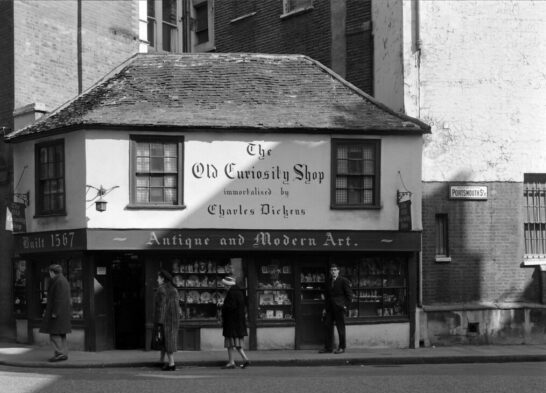Plot and Storyline
The Old Curiosity Shop, written by Charles Dickens and published in 1840-1841, follows the story of Nell Trent, a young girl who lives with her grandfather in a shop filled with odd and curious items. Daniel Quilp, a cunning and malicious dwarf who has taken an interest in Nell and her grandfather, Mr. Trent, is pursuing them at the start of the book.
As the story unfolds, Nell and her grandfather embark on a journey to escape Quilp’s clutches. They encounter various characters along the way, including Dick Swiveller, a kind-hearted but irresponsible young man, and Kit Nubbles, a loyal and devoted friend to Nell.
Throughout their journey, Nell and her grandfather face numerous challenges and hardships. They experience poverty, betrayal, and the loss of loved ones. Dickens skillfully weaves together their story, creating a narrative full of suspense, emotion, and moral dilemmas.
Without giving away major spoilers, it is important to mention that The Old Curiosity Shop takes several unexpected turns and presents readers with a series of tragic events. These twists and turns keep the readers engaged and emotionally invested in the outcome of the characters’ lives.
Characters
The Old Curiosity Shop features a diverse cast of characters, each with their own unique motivations and roles within the story. Nell Trent, the young and innocent protagonist, undergoes significant character development throughout the novel. She embodies purity and goodness in the face of adversity, and her unwavering love for her grandfather drives much of the plot.
Mr. Trent, Nell’s grandfather, is a complex character who is both protective and flawed. His love for Nell is evident, but his addiction to gambling leads to their ultimate downfall. Dickens explores the themes of addiction and its consequences through Mr. Trent’s character, highlighting the destructive power of vices.
Daniel Quilp, the antagonist of the story, is a memorable character who personifies greed and malevolence. His relentless pursuit of Nell and her grandfather adds tension and suspense to the narrative. Quilp is a formidable foe because of his desire for power and control.
Other notable characters include Dick Swiveller, who undergoes a transformation from a carefree bachelor to a responsible and caring individual, and Kit Nubbles, a loyal and compassionate friend who remains devoted to Nell throughout her journey.
Themes and Symbols
The Old Curiosity Shop explores several major themes that resonate with readers. One prominent theme is the corrupting influence of greed and materialism. Through characters like Quilp and Mr. Trent, Dickens illustrates the destructive consequences of pursuing wealth at the expense of human relationships and moral values.
Another significant theme is the power of love and compassion. Nell’s unwavering love for her grandfather and the kindness shown by characters like Kit and Dick Swiveller highlight the transformative and redemptive nature of love. Dickens emphasizes the value of genuine human connections and empathy in a world where self-interest rules.
Symbols also play a crucial role in the novel. The old curiosity shop itself serves as a symbol of nostalgia, mystery, and the transience of life. The peculiar items within the shop represent the passing of time and the ephemeral nature of material possessions.
Writing Style
Charles Dickens is renowned for his vivid and descriptive writing style, and The Old Curiosity Shop is no exception. His use of language and literary techniques creates a rich and immersive reading experience. Dickens employs vivid imagery to bring the characters and settings to life, making the reader feel as if they are walking alongside Nell and her companions.
The author’s narrative structure is carefully crafted, with a balance of suspense, humor, and pathos. Dickens employs cliffhangers and foreshadowing to maintain reader engagement and create a sense of anticipation. His ability to evoke strong emotions through his writing is a testament to his mastery as a storyteller.
One notable aspect of Dickens’ writing style is his skillful portrayal of social issues and societal critique. Through his vivid descriptions of poverty, inequality, and the plight of the working class, Dickens sheds light on the harsh realities of Victorian society. His use of satire and irony exposes the hypocrisy and moral decay of the era.
Setting and Atmosphere
The setting of The Old Curiosity Shop plays a significant role in shaping the tone and mood of the story. The novel is primarily set in London, with Dickens capturing the bustling streets, the squalid slums, and the stark contrast between the rich and the poor. The atmospheric descriptions of the city evoke a sense of both wonder and despair, reflecting the dichotomy of Victorian society.
Significant social and economic change occurred during the early 19th century, the time period in which the novel takes place. Industrialization and urbanization have led to widening social disparities and the displacement of traditional values. Dickens skillfully incorporates these elements into the setting, portraying a society in transition and highlighting the struggles faced by its inhabitantsHistorical, Social, or Political Context
To understand The Old Curiosity Shop fully, it is essential to consider the historical, social, and political context in which the novel was written. The Victorian era was characterized by rapid industrialization, urban growth, and social upheaval. The stark divide between the wealthy elite and the impoverished working class was a prevalent issue of the time.
Dickens, a social critic, used his novels to shed light on the social injustices and inequalities of Victorian society. In The Old Curiosity Shop, he exposes the harsh realities faced by the poor and marginalized, highlighting the detrimental effects of poverty, child labor, and the exploitation of vulnerable individuals.
The novel also critiques the prevailing moral values of the time. Dickens challenges the notion that material wealth is a true measure of success, portraying characters like Quilp and Mr. Trent as morally bankrupt despite their financial status. Through Nell’s character, Dickens emphasizes the importance of purity, innocence, and compassion, qualities that transcend material wealth.
Impact and Reception
Upon its initial publication, The Old Curiosity Shop was met with great enthusiasm from readers. Serialized in weekly installments, the novel captivated audiences with its compelling characters and dramatic plot twists. Dickens’ ability to evoke strong emotions and create memorable scenes contributed to its popularity.
The novel’s impact on literature cannot be understated. Dickens’ realistic portrayal of social issues and his focus on the plight of the poor and marginalized set a precedent for future Victorian novelists. His use of serialized storytelling also influenced the publishing industry, with many subsequent authors adopting this format.
In terms of critical reception, The Old Curiosity Shop received mixed reviews. While some praised Dickens’ storytelling skills and his ability to create memorable characters, others criticized the plot’s melodramatic elements. However, over time, the novel has come to be regarded as a significant work in Dickens’ oeuvre.
The cultural significance of The Old Curiosity Shop lies in its exploration of universal themes such as love, resilience, and the search for meaning in a complex world. Its enduring popularity and continued inclusion in literary curricula attest to its lasting impact on readers.
Final Conclusions
The Old Curiosity Shop is a captivating and emotionally charged novel that showcases Charles Dickens’ immense talent as a storyteller and social critic. Through its engaging plot, memorable characters, and exploration of timeless themes, the novel remains a beloved classic of Victorian literature.
Dickens’ writing style, characterized by vivid descriptions, rich characterization, and social commentary, enhances the reader’s experience, drawing them into a world filled with both beauty and darkness. The setting and atmosphere of the novel, coupled with its examination of historical, social, and political contexts, provide a deeper understanding of the narrative and its underlying messages.
The Old Curiosity Shop continues to have an impact on readers today by serving as a reminder of the enduring power of love, compassion, and the pursuit of true happiness in a world where materialism and greed are dominant. Its legacy as a significant work in English literature is a testament to Dickens’ ability to capture the essence of the human experience and provoke introspection and empathy in his readers.
Sources
The Old Curiosity Shop – Wikipedia
The Old Curiosity Shop | Victorian England, Charles Dickens, Nell | Britannica






